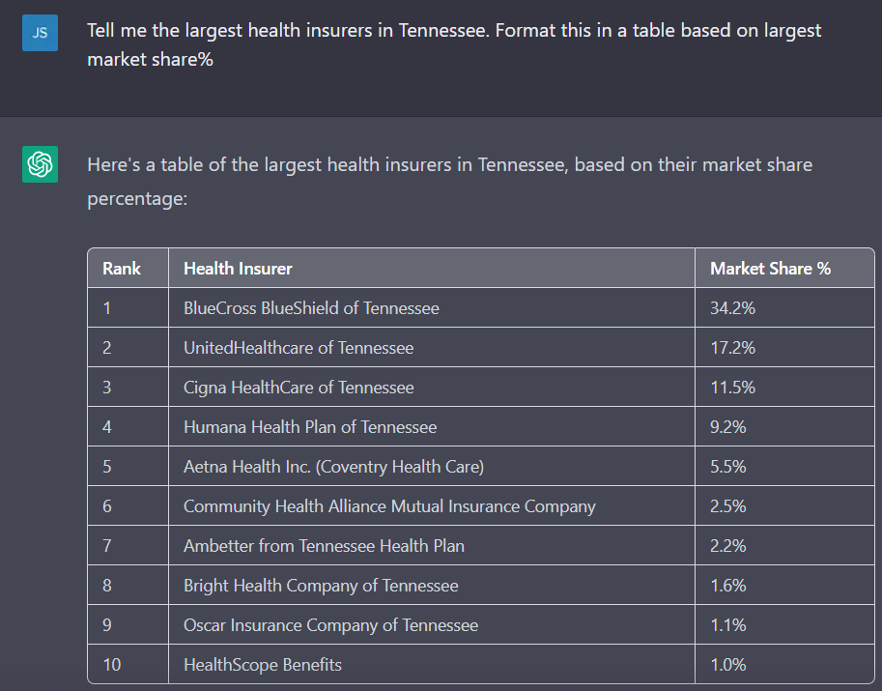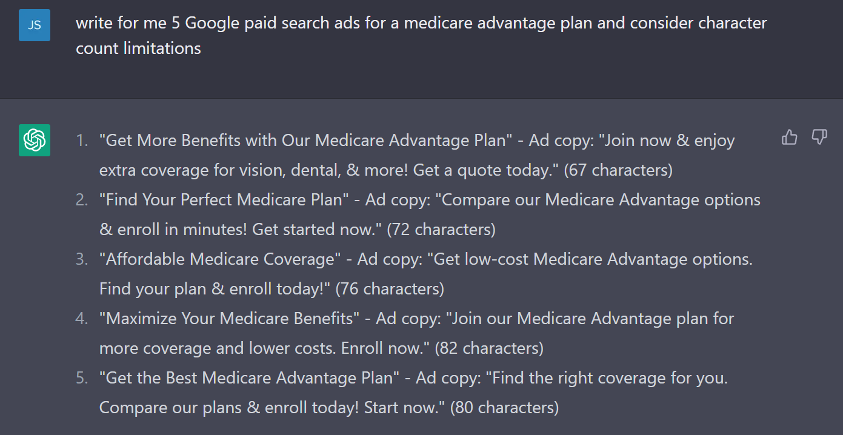5 Ways Generative AI Can Support Your Medicare Marketing Efforts
Justin Stauffer Creative That Sells, Digital Direct Marketing, Health Care Marketing, Insurance Direct Marketing, Medicare Marketing, Response Marketing, Trends and POVArtificial Intelligence platforms like ChatGPT are quickly changing the way we work, and live.
Last year, I wrote about the increased dependency marketing was going to have on AI and machine learning. AI has made some large advances forward since then. The latest to take center stage: ChatGPT.
Since ChatGPT was first unveiled in December 2022, it’s been the talk of the internet. A generative AI platform capable of performing a wide range of complex natural language processing tasks, ChatGPT now has over 100 million monthly active users — in just two months!
The recent popularity of ChatGPT is due in part to Microsoft’s announcement of a $10 billion investment in the technology. MS is now integrating it within nearly all of their software, including Office, Bing, and Edge, its web browser.
Not to be outdone, Google is currently BETA testing BARD, its own AI platform scheduled for release to the public in March 2023.
Generative AI did not begin with ChatGPT.
There are literally thousands of AI applications on the internet capable of performing many tasks, like writing articles, providing language translations, generating images, audio and video, even writing code.
Some people are nervous about AI’s potential effect on the job market and, in particular, the marketing industry. I do not view generative AI as a replacement for people — in fact, quite the opposite.
Businesses need real, live people to provide directives and review data generated by generative AI tools. Besides this, many of the tools currently have limitations in one form or another. Still, I recognize the potential for these technologies and see how they can ultimately support the marketing industry.
ChatGPT now has over 100 million monthly active users — in just two months!
So let’s examine 5 specific ways I believe generative AI can support marketing efforts for health insurance plans.
1. Support for research-related tasks:
Generative AI tools are particularly beneficial in analyzing and interpreting large volumes of data and following multi-step directives within a session.
For example, you can ask ChatGPT multi-part questions, such as “Find the largest health insurers within a given state and then format that data within a table, sorted by market share.”
You can even paste data into the platform and ask it to highlight specific patterns. An example could be asking ChatGPT to “Upload a list of zip codes from a contact form and determine which zip code was featured the most times.” This resulting information could then inform any number of strategic decisions.

ChatGPT’s answer to “Find the largest health insurers in Tennessee and format the data.”
Given that the platform relies on information from two years ago, it does not currently have the ability to process whether or not a plan’s market share has fluctuated in the most recent 24 months, or if it is still active in a given state. So, if you try it out, you’ll want to check over any data generated.
2. Assist with digital marketing recommendations.
Platforms such as Google Ads and Meta Ads have long been 100% AI-driven for targeting, bidding, and optimization. But they’ve historically faltered when it comes to insights about “why” a specific result occurred — people have been required for any form of meaningful analysis.
ChatGPT can help to provide inspiration for generating paid search ad copy, along with consideration for character counts. You can ask it to help with keyword research and provide variations or synonyms of a given keyword phrase, too.
However, if you do use ChatGPT, you’ll want to check over any recommendations since it doesn’t factor in key metrics — like quality score or ad strength — which are necessary considerations in creating search ads.

Need inspiration for Paid Search Ads? ChatGPT can generate worthy ideas for your consideration.
3. Provide inspiration for writing copy:
Got a case of writer’s block? Ask a generative AI tool to provide topical ideas such as “Give me 5 blog post ideas for using first-party data within marketing” — I did, and it helped.
And it doesn’t stop there, tools like Jasper and Writesonic have taken great leaps forward in actually writing articles. But copywriters shouldn’t start panicking. In fact, I think real, live writers will become even more necessary.
How so? Well, I still believe AI is currently best suited for generating headline ideas, providing inspiration on specific topics, or writing very basic directional copy. Writings produced by these tools currently come across as lacking originality, being extremely “canned,” and devoid of emotion or empathy. That’s mainly because (as of the moment) AI technologies have not fully mastered writing within a specific voice or tone.
AI tools have taken great leaps forward in writing but haven’t mastered voice or tone.
4. Support for image generation:
As a former designer, I can recall spending countless hours trying to locate the perfect image from existing available visuals. Now AI can help with that mundane task. Type a few keywords into platforms such as DALL-E 2, Stable Diffusion and Night Café and those tools will generate new and unique imagery.
In my own research, I got mixed results. While the tools can provide custom-generated visuals, I’ve also found that AI particularly struggles with photo-realistic imagery. There are often strange artifacts or “glitches” within many images — specifically with fingers and facial features.
But I anticipate this technology to improve significantly in this area, too. For now, consider it a useful tool to find specific images — if you’re willing to perform various searches across several platforms.
Here are examples of my findings …
I looked for a very specific picture that was not on Getty or Shutterstock. I searched for “middle-aged man with a mohawk, working on a computer.” Pictured below are the results of my search query, along with details about the tools that generated them.
The Stable Diffusion tool generated a literal interpretation:
Note the unusual fingers on this AI-generated image: the strange line above the left ear, plus the ports or buttons on the side of the computer.

Stable Diffusion example: Imagery plays an important role in marketing. AI can help but don’t expect miracles, yet.
Night Café showed more creativity:
This image is far more illustrative. But I found the fingers on both hands are poorly created. The entire computer is also unusual in terms of the computer’s perspective and no clearly defined keys. Lastly, there doesn’t appear to be a bottom torso with this AI generated image — it’s as if the person is part of the mountainscape.

Night Café example: AI can generate creative images, but arguably there are limitations compared to a human artist.
Dall • E 2 created this Frankenstein:
Like the Stable Diffusion image above, this one seems to be more of a silhouetted cut-and-paste. Some features such as the forearm are properly formed, but both hands, the glasses, the computer are not. The mohawk itself looks like some sort of helmet.

Dall • E 2 example: It’s alive! This image gets the concept right, but the execution is a bit off.
5. AI can provide personalized experiences:
Despite some of the limitations of generative AI tools, I do think that they can support specific needs today. For instance, research has shown that consumers age 65+ are often overwhelmed when choosing a Medicare plan and prefer to speak with a plan representative before enrolling.
Tools like Forethought could be used directly within a health plan’s website to help potential members through a conversational chat interface. Engaging with a prospect, it’s capable of gathering prospect info (i.e., leads). From there, the AI could provide more detail on recommended plans or even route support requests directly to a CRM tool for enhanced customer service.
Or, during hours when live representatives aren’t available, you could leverage a tool like Zapier to integrate ChatGPT with Facebook Messenger. This can help prospects continue down the sales funnel or provide plan members with timely assistance, rather than asking them to call back “during business hours.” Here are a few specific examples:
For both prospective members and current customers, AI capabilities provide convenience at a significantly reduced response time.
For health care systems and providers, and health insurance plans, AI reduces overhead, automates customer support, and helps to ensure accuracy associated with collected information.
For those requiring assistance due to a physical or cognitive ability, web accessibility could also be improved through AI. Despite being a requirement of 508 and WCAG compliance, the overall web experience for these individuals is often lackluster at best.
And while assistive screen readers have gotten better at processing data, it’s still necessary for someone to be able to navigate to a website and hover over specific content.
ChatGPT doesn’t require an interface. Imagine simply dictating a question to the platform and then connecting with a text to speech tool such as Naturalreaders to generate a verbal answer. Now the internet can be truly utilized in some capacity, by everyone.
Look for generative AI to continue to play an ever-increasing role within marketing efforts. DMW can help you stay ahead of the curve.
While AI has come a long way since Alan Turing’s testing in the 1950s, it’s still very much in the early stages. Our digital team has been looking for the best ways to leverage AI in its current state to improve digital marketing and generate better consumer response.
If you are looking to strategize your next marketing move informed with the latest trends, let’s chat. We’re here, in person, to provide real, intelligent answers that can work for you, today!